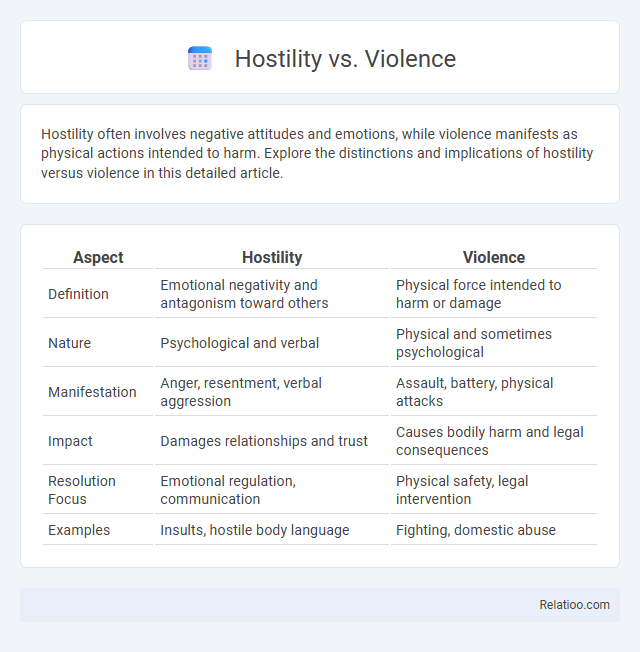Hostility often involves negative attitudes and emotions, while violence manifests as physical actions intended to harm. Explore the distinctions and implications of hostility versus violence in this detailed article.
Table of Comparison
| Aspect | Hostility | Violence |
|---|---|---|
| Definition | Emotional negativity and antagonism toward others | Physical force intended to harm or damage |
| Nature | Psychological and verbal | Physical and sometimes psychological |
| Manifestation | Anger, resentment, verbal aggression | Assault, battery, physical attacks |
| Impact | Damages relationships and trust | Causes bodily harm and legal consequences |
| Resolution Focus | Emotional regulation, communication | Physical safety, legal intervention |
| Examples | Insults, hostile body language | Fighting, domestic abuse |
Defining Hostility and Violence
Hostility refers to an attitude or feeling of animosity, resentment, or opposition that may not always result in physical acts, whereas violence involves the use of physical force intended to cause harm, damage, or injury. Hostility can be expressed through verbal aggression, cold behavior, or psychological tactics, making it a broader emotional or social state compared to the tangible and aggressive nature of violence. Understanding these distinctions helps you recognize underlying tensions and prevent escalation from hostile feelings to violent actions.
Psychological Roots of Hostility
Hostility stems from deep-seated psychological factors such as past trauma, chronic stress, and perceived threats to self-worth, which activate defensive mechanisms and negative emotions. Unlike violence, which involves physical acts of aggression, hostility primarily manifests as sustained negative attitudes, anger, and resentment toward others. Understanding the psychological roots of hostility reveals patterns of cognitive distortion and emotional dysregulation that can escalate into aggressive behavior if unaddressed.
Manifestations of Hostile Behavior
Hostile behavior manifests through verbal aggression, such as insults and threats, physical actions like hitting or damaging property, and psychological tactics including intimidation or manipulation. These behaviors often escalate from internal feelings of anger and resentment, leading to outward expressions that disrupt social harmony and cause emotional or physical harm. Understanding the distinctions and signs of hostility, violence, and hostility helps you recognize and address these manifestations effectively in various interpersonal contexts.
Understanding Violence: Types and Triggers
Violence manifests in various forms, including physical, psychological, and structural, each triggered by distinct factors such as social injustice, provocation, and environmental stressors. Understanding these triggers is crucial to addressing the root causes and preventing escalation from hostility to violence. Hostility often precedes violence, characterized by aggressive attitudes that may or may not result in overt harmful actions.
Key Differences Between Hostility and Violence
Hostility refers to negative attitudes or feelings of anger and aggression that may not involve physical actions, while violence involves deliberate physical force intended to harm or damage. Hostility often manifests as verbal aggression or psychological intimidation, contrasting with violence's direct physical impact. Understanding these distinctions helps you recognize that hostility can escalate into violence but remains primarily an emotional or mental state.
The Role of Emotions in Hostility and Violence
Emotions such as anger, fear, and frustration play a critical role in differentiating hostility from violence, with hostility often rooted in sustained negative feelings and violent acts emerging when these emotions escalate into physical aggression. Hostility involves internal emotional states and attitudes that may or may not lead to overt violence, whereas violence represents the external, harmful expression of those intense emotions. Understanding the emotional triggers and regulatory mechanisms behind hostility can help mitigate the transition from hostile thoughts to violent behaviors.
Social and Environmental Influences
Hostility often emerges from social and environmental stressors such as poverty, discrimination, and community violence, shaping individuals' emotional and behavioral responses. Violence represents the physical manifestation of these hostile feelings, influenced by factors like exposure to aggressive behavior, lack of social support, and environmental instability. Understanding the interplay of social influences and environmental context is crucial in addressing both hostility and violence within communities.
Consequences for Individuals and Society
Hostility, characterized by negative attitudes and emotions, can lead to increased stress and emotional distress for individuals, impacting mental health and interpersonal relationships. Violence, as a physical manifestation of hostility, results in more severe consequences including injury, trauma, and societal disruption, escalating crime rates and straining public resources. Your understanding of these distinctions is crucial for addressing root causes and fostering interventions that promote safety and well-being in communities.
Preventing Hostility and Violence
Preventing hostility and violence requires implementing effective conflict resolution strategies, promoting empathy, and fostering open communication in both individual and community settings. Early intervention programs, educational initiatives on emotional regulation, and creating safe environments significantly reduce the escalation of aggressive behaviors. Collaborative efforts involving mental health professionals, educators, and law enforcement enhance prevention outcomes and support long-term social harmony.
Strategies for Conflict Resolution
Effective strategies for conflict resolution distinguish between hostility, violence, and aggression by addressing underlying emotions and behaviors. Mediation and active listening techniques reduce hostility by fostering empathy and understanding, while nonviolent communication helps prevent escalation into violence. Implementing restorative justice practices promotes accountability and healing, transforming aggressive confrontations into constructive dialogue.

Infographic: Hostility vs Violence
 relatioo.com
relatioo.com